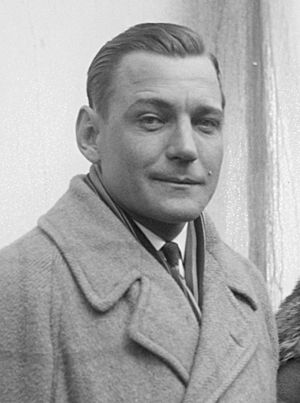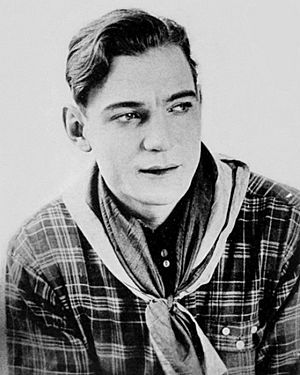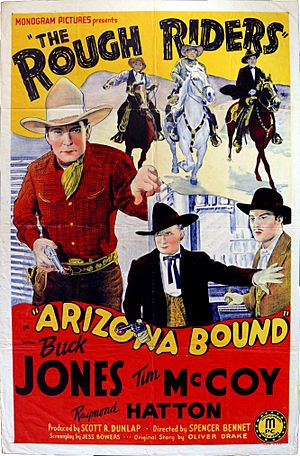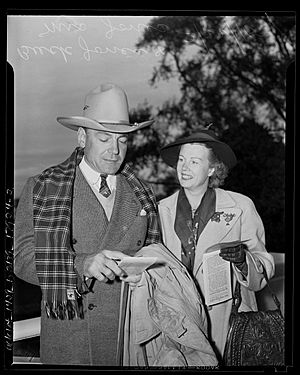Buck Jones facts for kids
Quick facts for kids
Buck Jones
|
|
|---|---|

Jones in 1926
|
|
| Born |
Charles Frederick Gebhart
December 12, 1891 Vincennes, Indiana, U.S.
|
| Died | November 30, 1942 (aged 50) Boston, Massachusetts, U.S.
|
| Other names | Charles Jones |
| Occupation | Actor |
| Years active | 1914–1942 |
| Spouse(s) |
Odille Osborne
(m. 1915) |
| Children | 1 |
Buck Jones was a famous American actor. He was best known for starring in many popular Western movies. His real name was Charles Frederick Gebhart. He was born on December 12, 1891, and passed away on November 30, 1942. When he first started acting, he was sometimes called Charles Jones.
Contents
Early Life and Army Days
Buck Jones was born Charles Frederick Gebhart near Vincennes, Indiana. This was on December 12, 1891. When he was just 16, he joined the United States Army. His mother helped him sign up by saying he was 18.
He was sent to the Philippines in 1907. There, he served in battles during the Moro Rebellion and was even hurt. He left the Army in 1909. Buck also loved race cars and worked as a test driver for a car company. He rejoined the Army later, hoping to learn to fly planes. He left the Army for good in 1913.
Becoming a Cowboy and Movie Star
After his time in the Army, Buck became a cowboy. He worked on a big ranch called the Miller Brothers 101 Ranch in Oklahoma. At horse shows, he met Odille "Dell" Osborne. She was also a professional horse rider. They fell in love and got married in 1915. They even got married during a Wild West show performance!
Later, Buck moved to Los Angeles, California. He wanted to work in movies. He started at Universal Pictures as a small actor and stuntman. He earned $5 a day. He then worked for other studios like Fox Film Corporation. His pay went up to $150 a week. The owner, William Fox, saw his talent. Buck got his first main role in a movie called The Last Straw in 1920.
Reaching Stardom
By 1925, Buck Jones had made over 160 movies. He became one of the top cowboy actors, like Hoot Gibson and Tom Mix. He even made three films with a young actress named Carole Lombard.
In 1928, Buck tried to start his own movie company. But his non-Western film, The Big Hop, didn't do well. He also started a touring Wild West show. This show was very expensive and failed because of money problems in 1929.
When "talking pictures" (movies with sound) became popular, Westerns were less favored. Major studios weren't hiring cowboy stars. But in 1930, Buck signed with Columbia Pictures. He starred in Westerns for $300 a week. This was less than before, but his voice was good for sound movies. His films were very successful. This made him a big movie name again. He starred in many Westerns and movie series for Columbia and Universal Pictures in the 1930s.
Later in the 1930s, "singing cowboys" became popular. Buck was in his late 40s and didn't fit these roles well. He rejoined Columbia in 1940. He starred in a new movie series called White Eagle. It was a big hit. His last Western movies were with his friends Tim McCoy and Raymond Hatton. They were called "The Rough Riders."
Radio Show and Merchandise
In 1937, Buck Jones had his own radio show called Hoofbeats. It was a 15-minute program. The show told exciting stories about Buck Jones and his horse, Silver. A cereal company, Grape Nuts Flakes, sponsored the show.
Buck also let companies use his name and picture for products. He endorsed Post Grape-Nuts Flakes. He also had a short-lived magazine. One very popular item was the Daisy "Buck Jones" model air rifle. This special air rifle even had a compass and a sundial on it! It was one of Daisy's best-selling air rifles for many years.
He also had several books in the Big Little Book series, like:
- Buck Jones and The Two Gun Kid (1937)
- Buck Jones and The Night Riders (1937)
- Buck Jones and The Rock Creek Cattle War (1938)
Tragic Death
Buck Jones was one of the many people who died in a terrible fire. This happened at the Cocoanut Grove fire in Boston, Massachusetts, on November 28, 1942. He was trapped inside the nightclub. Buck passed away two days later, on November 30, at 50 years old.
Family Life
Buck Jones had a daughter named Maxine Jones. She was born in 1918. Maxine married actor Noah Beery, Jr. in 1940. They were married until 1966. Later, Maxine married Nicholas Firfires, a famous Western artist. Maxine and Nicholas were married until her death in 1990. They did not have any children.
Awards and Recognition
Buck Jones was honored for his work in movies.
- In 1960, he received a star on the Hollywood Walk of Fame. You can find his star at 6834 Hollywood Blvd.
- In 1997, a Golden Palm Star was dedicated to him on the Palm Springs, California, Walk of Stars.
A Few of His Movies
- The Last Straw (1920)
- Just Pals (1920)
- The Big Punch (1921)
- Dick Turpin (1925)
- The Arizona Romeo (1925)
- The Lone Rider (1930)
- The Texas Ranger (1931)
- White Eagle (1941)
- Dawn on the Great Divide (1942)
See also
 In Spanish: Buck Jones para niños
In Spanish: Buck Jones para niños




